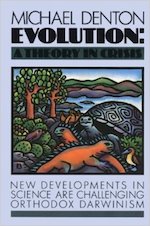 Evolution
Evolution
Biologist Michael Denton Revisits His Argument that Evolution Is a “Theory in Crisis”
 A new quarterly journal, Inference: International Review of Science, turns a skeptical eye on the culture and practice of science.
A new quarterly journal, Inference: International Review of Science, turns a skeptical eye on the culture and practice of science.
Of particular interest in the first issue is an essay by our colleague, biologist Dr. Michael Denton, on “Evolution: A Theory in Crisis Revisited,” first of a promised three-part series. Denton renews and expands his critique of Darwinian theory. This bears some discussion.
Many Darwin defenders are troubled that credible scientists doubt their viewpoint. As a result, we occasionally hear rumors promulgated by ID critics claiming that Michael Denton is no longer skeptical of Darwinian evolution, or even that he has abandoned the argument in his influential 1985 book, Evolution: A Theory in Crisis. Such rumors are quashed by Denton’s article in Inference, where he observes:
In Evolution: A Theory in Crisis (Evolution), published in 1985, I argued that the biological realm is fundamentally discontinuous. The major taxa-defining innovations in the history of life have not been derived from ancestral forms by functional intermediates. … The contrary view remained predominant among evolutionary biologists until, at least, the 1980s, and remains predominant as the view offered the public today.
There have been massive advances and discoveries in many areas of biology since Evolution was first published. These developments have transformed biology and evolutionary thought. Yet orthodox evolutionary theory is unable to explain the origins of various taxa-defining innovations.
This was my position in Evolution.
It remains my position today
Clear enough? Denton kicks off the article by taking on one of the most famous icons of evolution, the Galápagos finches, showing that they represent microevolutionary changes but do not demonstrate significant evolution:
From the emerging developmental genetic picture, it is now relatively easy to envisage how gradual adaptive fine-tuning of the expression patterns of a handful of genes could result in the different beak forms of the Galápagos finches we see today.
The evolution of finch beaks requires no causal agency beyond natural selection. Some finch beaks proved advantageous; others, not. The lesson of the Galápagos, and all such cases of microevolution, is that cumulative selection will work its magic just so long as there is an empirically known or plausible functional continuum, at the morphological or genetic level, leading from an ancestral species or structure to a descendent species or structure.
So the evolution of the Galápagos finches is a plausible evolutionary but one entailing only very minor evolutionary change. Well, are there plausible accounts of evolutionary change on a larger scale? Denton examines one case — the origins of the complex reproductive behavior of the European eel.
These eels begin their lives just off the East Coast of the United States, and undergo many morphological changes, which cause sexual differentiation as they migrate to the shores of Europe. They then migrate back across the Atlantic, undergoing more morphological changes, and return to their spawning grounds in the Sargasso Sea. The story is a lot more complicated than that, and Denton discusses these processes and behaviors in detail. He finds that they are very difficult to explain in evolutionary terms:
The evolutionary factors responsible for such an extraordinarily roundabout way of reproducing are mystifying. What tiny adaptive steps led from the reproductive habits of a normal fish to such a grotesque life cycle? What adaptive significance do such sexual metamorphoses serve? What selective pressures led the adult eels to dissolve their guts and stop feeding to make the journey back to the Sargasso Sea? Why does the anus migrate from the tail to mid-abdomen during the final stages of larval maturation? Why do males stay in Europe for six years and females for nine before returning to the ocean? What selective advantage did eels achieve by making the transition from salt to fresh water? What conceivable “long series of gradations … each good for its possessor” could possibly have orchestrated the whole performance? I think it would be hard to invent a story more difficult to comprehend in terms of cumulative selection.
He notes that examples like this support his conclusions in Evolution: A Theory in Crisis:
Today, thirty years later, despite the discovery of a huge number of new fossil forms, it is still true, as Darwin confessed, that “the distinctness of specific forms … not … blended together by innumerable transitional links is a very obvious difficulty.”
But Denton now adds another critique of Darwinian evolution. There are some beneficial features that cannot be built in a step-by-step process. But there are other features that are prevalent throughout biology and that seem to provide no particular adaptive benefit. Denton explains:
Evolutionary novelties pose one obvious challenge to Darwinian theories. The fact that, in most cases, their adaptive status is clearly in doubt poses another. … The number of segments making up the various parts of the body of different groups of fossil arthropods, including shrimps, lobsters, trilobites, and spiders, is fantastically variable, yet each group almost always has the same number of segments in each body part despite the bizarre and complex variation in its lifestyle and adaptations. On even a cursory consideration of the vast inventory of invertebrate type-defining novelties described in this major work, it would appear that the great majority serve no adaptive purpose. … If a significant proportion of the taxa-defining patterns serve no specific function, as Owen argued in the case of the tetrapod limb, then cumulative selection cannot provide an explanation for the origin of a significant fraction of the defining homologs, and hence for the natural system itself.
This resembles the arguments Denton made in a 2013 BIO-Complexity paper, “The Types: A Persistent Structuralist Challenge to Darwinian Pan-Selectionism,” where he challenges the view that biological organisms are accidents of random mutation and natural selection, instead adopting a structuralist view that body plans are like Platonic “types,” woven into the fabric of nature.
Of course there are some conserved features that evolutionary biologists laud as the key to understanding how body plans arose. Denton observes how proponents of “evo devo” think that conserved developmental genes can be redeployed in different organism to control the development of different parts, explaining evolutionary transitions from one form to another:
A remarkable experiment, described in Neil Shubin’s Your Inner Fish, demonstrated how one conserved toolkit component, a signaling molecule known as “sonic hedgehog protein,” had the same effect on the development of shark fins as on mammalian and chicken digits. Shubin was suitably impressed by this remarkable result. “It means,” he observed, “that this great evolutionary transformation [from fish fins into limbs] did not involve the origin of new DNA.” Old wine had, instead, been poured into new bottles. “Much of the shift likely involved using ancient genes, such as those involved in shark fin development, in new ways to make limbs with fingers and toes.” This view is today widespread among researchers in evolutionary developmental biology, known as evo-devo.
Michael Behe has often made the point that genetic similarity between two proteins may indicate common descent (and I would add that functional genetic similarity could indicate common design rather than common descent), but that doesn’t necessarily mean there’s a stepwise evolutionary pathway connecting the two to their putative ancestor. Denton offers a similar response to Shubin, noting that genetic similarity in developmental toolkits may suggest a common origin, but that doesn’t mean that the differences we observe can be explained in adaptive terms:
The fact that the same toolkit is used universally supports descent with modification, but it does not explain how relevant novelties came about during decent with modification, or whether they were adaptive. That sugar and carbonic acid are composed of the same atoms does not imply that sugar can be converted into carbonic acid by means of a series of individual atomic steps; and that the same atoms, proteins, cell types, gene circuits, gradients, and Turing mechanisms are used to make fins, hands, reptile scales, feathers, fir cones, and flowers does not imply anything beyond the obvious fact that these structures were made using a common toolkit.
Indeed, Denton finds that some differences between homologous structures are very difficult to explain via Darwinian evolution. He tackles the example of “enucleated” red blood cells, blood cells that lack a nucleus, in the major groups of mammals (monotremes, marsupials, and placentals). Denton describes the complex biological processes that cause a blood cell to expel its nucleus. He finds:
There is no known intermediate type of cell midway between the enucleate cell and the nucleated red cells of any other vertebrate species. As I argued in Evolution, where there is an empirical absence of transitional forms, envisaging plausible hypothetical intermediates invariably proves impossible. And so it is here.
Vertebrate erythrocytes are either nucleated or enucleated. But without intermediates or partially enucleated cells, there would be no way of approaching the enucleate state gradually. If there are no intermediates, then the utility of the enucleate red cell could only have been tested when the enucleate cell enters the bloodstream and is forced through the smallest capillaries. The very first test of the utility of the enucleate red cell could only have been carried out after the complex and unique machinery for pushing out the nucleus was already in place.
He closes by noting that many “puzzles” plague evolutionary biology — puzzles that he will explore in parts two and three of this paper. I will look forward to those.

